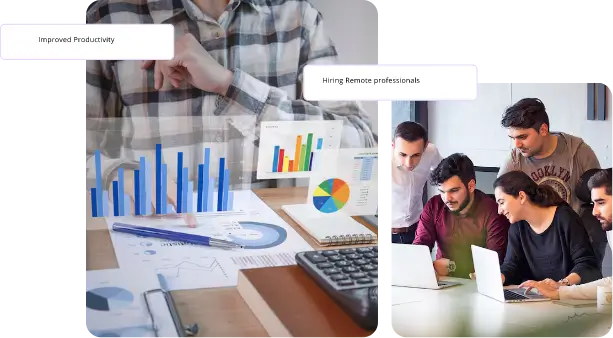Home / A / Attendance Reporting
What Is Attendance Reporting?
Good attendance reporting helps control employee productivity, ensures the company's compliance, and optimizes payroll management. Monitoring employee attendance systematically enables organizations to base their decisions on facts, identify common problems, and address them proactively. The article provides an overview of attendance reporting, its role in organizations, its operation, examples, benefits, risks, differences from other methods, and how Time Champ can enhance your attendance management.
What Is Attendance Reporting?
Attendance reporting is about collecting and examining information on when employees appear at work, when they are absent, and how late or early they come. These reports enable companies to gain insight into their workforce, which helps them schedule employees, calculate payroll, and comply with labor laws.
Why Is Attendance Reporting Important?
Reporting attendance accurately provides several important benefits.
- Payroll Accuracy: Proper payroll management guarantees employees are paid for the actual time they spend working.
- Compliance: Ensures the company adheres to labor regulations by accurately recording when employees are working and not working.
- Productivity Monitoring: It tracks attendance to identify any patterns that may impact the company's productivity.
- Resource Allocation: Easy planning and allocation of resources is possible when you know how many people are likely to be present.
How Does Attendance Reporting Work?
You can use various approaches to track attendance.
1. Manual Methods:
Several businesses still rely on paper and punch cards. At the beginning and end of their shifts, employees record their start and end times. Even so, it takes longer and may result in errors.
2. Digital Time Clocks
Many businesses now rely on digital systems for employees to record their arrival and departure using their computers, tablets, or phones. The systems keep track of the times as they happen.
3. Biometric Systems
Several companies use fingerprint or facial scanners to track employee attendance. It prevents employees from clocking in for one another.
4. Online Tools for Remote Work
Online apps are available for remote teams to track the time employees spend working from home.
Once the data is gathered, the system generates attendance reports for HR and managers to review. Some reports are provided each day, some weekly, and some monthly.
Examples of Attendance Reporting in Practice
Example 1: Retail Store Chain
With the use of a digital attendance system, employees enter and exit the workplace via a mobile app. This enables managers to receive weekly reports and address any late issues.
Example 2: Manufacturing Plant
A manufacturing firm sets up biometric scanners outside the building. Every day, the system generates an attendance report, which helps supervisors manage staff schedules and ensure sufficient staffing levels.
Example 3: Remote Workforce
A tech company with employees working from home tracks their attendance using a tool linked to project management software. As a result, you can check who is working at any moment and the progress of your projects in real-time.
Key Benefits and Risks of Attendance Reporting
Benefits
- Enhances Accountability: Encourages every employee to be responsible by meeting their deadlines.
- Data-Driven Decisions: Data helps leaders decide on the best way to schedule and organize staff.
- Cost Management: Ensures employee wages are accurately accounted for by monitoring both overtime and absenteeism.
Risks
- Privacy Concerns: Employee privacy concerns may arise if companies keep their attendance data confidential or fail to explain how it is used.
- Data Accuracy: When data is incorrectly entered, or the system is incorrect, the results can lead to payroll errors and compliance issues.
- Overusing Automation: Depending heavily on automation without regular auditing can lead to missing some abuses or unusual occurrences.
Comparison Table: Attendance Reporting vs Time Tracking
| Feature | Attendance Reporting | Time Tracking |
|---|
How Time Champ Enhances Attendance Reporting
Time Champ offers a comprehensive suite of tools to facilitate attendance reporting.
- Automatic Data Capture: Lessens incorrect information by collecting each person's attendance in real-time.
- Choice of Reports: Easily generate detailed reports that match the needs of the organization, which helps with analysis and decision-making.
- Integration Capabilities: It seamlessly integrates with HR and payroll systems, facilitating easy data transfer.
- Compliance Support: Provides support for maintaining correct records that meet job safety and labor law needs.
Attendance Reporting for Proactive HR Strategies
1. Identifying Trends and Patterns:
The aim of reporting attendance isn't only to log absences but also to discover their reasons. HR teams can use trends in tardiness, absenteeism, and shift coverage to identify signs of burnout, disengagement among employees, or schedule-related concerns.
2. Improving Employee Engagement:
Truthful attendance information helps create confidence in leaders. If attendance policies are applied consistently for all employees, they are more likely to feel accountable and involved. Noticing those who always attend meetings can increase the team's motivation.
3. Optimizing Workforce Planning:
With advanced reporting, managers are better able to predict the number of staff required. When absenteeism increases due to the flu season, HR can prepare in advance for temporary help.
4. Driving Informed Decisions:
Attendance data becomes valuable for making decisions when you use Time Champ. Managers may decide to adjust schedules or offer flexible work arrangements to benefit both the team's productivity and the well-being of its members.
Related Terms
- Absenteeism: Absence from work for no good cause.
- Tardiness: Consistently arriving late for work or breaks is considered tardiness.
- Biometric Attendance System: Using special biological traits to check if someone is at work.
- Payroll Integration: Connecting time management with payroll for correct calculation of wages.
- Leave Management: The process of taking care of employees' leave requests and balances.

